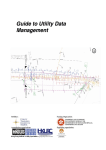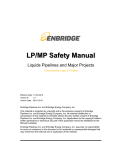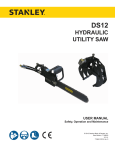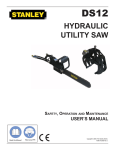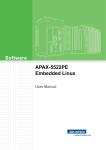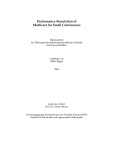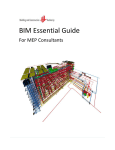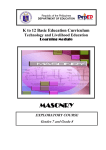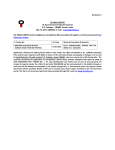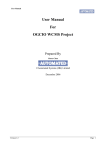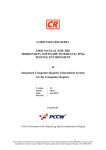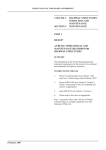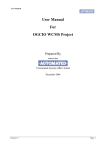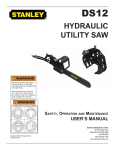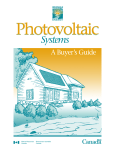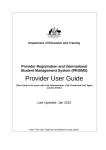Download - Hong Kong Institute of Utility Specialists
Transcript
Acknowledgements The authors would like to acknowledge the financial fund under Professional Service Development Assistance Scheme (PSDAS) of Commerce and Economic Development Bureau, The Government of the Hong Kong Special Administration Region as well as technical support of Hong Kong Institute of Utility Specialists (香港管綫專業學會)and Hong Kong Utility Research Centre (香港 管線管理研究中心)as well as their company members. Additionally, the support of relavant government departments should be acknowledged for their contribution to the information related to operation, standards, and contract requirements. List of Company Members of HKIUS (according to alphabet): (1) APC Surveying & Building Limited (2) BUDA Surveying Limited (3) B.P. (Building & Engineering) Co., Ltd (4) EGS (Asia) Limited (5) Freyssinet Hong Kong Ltd. (6) INNO Pipe Engineering Limited (7) Insituform Asia Limited (8) Jetrod Pipeline Consultant and Engineering Ltd (9) Patrick Yuen Underground Detection Company Limited (10) Toptime Technologies Ltd. (11) US & Associates Consulting Co.,Ltd (12) UtilityINFO Limited (13) U-Tech Engineering Company Ltd. Editor in Chief Editor Consultant Ir Dr. King Wong L.M. Cheung, C.C. Chui, C.W. Hui, W.Y. So Mr. Kai Yip Kwok, Mr. Chun Fai Wong This guideline was done in May 2011 and this version is modified in May 2012. .............................................................................................................................................. Page2 FOREWORD After the disastrous landslip of 1994 occurred in Kwun Lung Lau on Hong Kong Island, the Government has paid more attention on utility maintenance with particular emphasis on leakage detection of buried water carrying services on both slopes and roads. The Government has increased resources and imposed additional legislation on the detection of underground utilities. As a direct result, the utility profession has been developing rapidly, and over the last decade, the number of “Utility Specialists” ( 管 綫 專 業 監 理 師 ) has grown as the Government’s requirements for Competent Persons to carry out the investigations has been implemented, in addition, Recognized Professional Utility Specialist (RPUS) (管綫專業監察師) has been recognized in recent years. However, lack of standard surveying methods, centralized monitoring systems and organized management, have lead to unsatisfactory investigation results. In order to address these issues, Hong Kong Institute of Utility Specialists (HKIUS) (香港管綫專 業學會), targeting the promotion of knowledge and good practice in the utility profession, collaborated with Hong Kong Utility Research Centre (HKURC)(香港管線管理研究中心) and supported by the funding from the Professional Services Development Assistance Scheme (PSDAS) of HKSAR, published a series of guide books and pamphlets in 12 disciplines of the utility profession in order to set standards for the practitioners to follow. As part of HKIUS continual effort to enhance the professionalism of the utility profession, it is the intention of the series that the quality of the survey can be raised and that utility related incidents can be avoided by performing high quality utility practices. Hopefully, the resulting benefits can extend to the general public. This issue provides good practice of using Pipe/Cable Locator (PCL) (管綫探測儀) in Utility Survey. It states the whole process and specification of conducting Utility Survey (using PCL) from planning to finishing stages and intended to be used by all personnel involved in the works. _________________________ Mr. Zico Kai Yip KWOK (郭啟業先生) President, HKIUS (2010-13) April, 2011 .............................................................................................................................................. Page3 TABLE OF CONTENT 1. INTRODUCTION ........................................................................................................................... 5 2. OBJECTIVE AND SCOPE ............................................................................................................. 6 3. PRE-SURVEY PREPARATION .................................................................................................... 7 3.1 Equipment .............................................................................................................................. 7 3.2 Planning ................................................................................................................................. 8 3.3 Statutory Requirement ........................................................................................................... 8 3.4 Personnel Requirement .......................................................................................................... 9 4. UTILITY SURVEY INSPECTION............................................................................................... 11 4.1 Calibration of PCL ............................................................................................................... 11 4.2 Detection Method ................................................................................................................. 11 4.3 Detection Techniques ........................................................................................................... 15 4.4 Depth measurement.............................................................................................................. 16 4.5 Current Measurement ........................................................................................................... 17 4.6 Marking ................................................................................................................................ 17 5. POST-SURVEY DATA PROCESSING ....................................................................................... 19 5.1 Inspection Report ................................................................................................................. 19 5.2 Accuracy and Quality Control ............................................................................................. 20 5.3 Record keeping .................................................................................................................... 21 6. LIMITATION OF PCL .................................................................................................................. 22 REFERENCES................................................................................................................................... 23 Appendix A: Abbreviations ............................................................................................................... 24 Appendix B: Related photographs ..................................................................................................... 28 Appendix C: Sample Materials .......................................................................................................... 29 B1 Utility Mapping Form (TOPO FORM ) ............................................................................... 29 B2 Utility Mapping Form (Form B) .......................................................................................... 30 B3 Utility Mapping Form (DETAIL SURVEY BOOKING FORM FORM) ........................... 31 B4 Survey Leveling Form .......................................................................................................... 32 B5 Survey Traverse Form .......................................................................................................... 33 B6 Survey Sketch Form ............................................................................................................. 34 .............................................................................................................................................. Page4 1. INTRODUCTION The underground utility system of Hong Kong is extremely complicated. Electric cables, water, sewage and gas pipes, telecommunication lines, etc. are buried underground in high density. Construction, repair and maintenance works of the utilities often involve excavation. Careless excavation works may cause damage to underground utilities and the cost of it can be high. It can paralyze the power and water supply and cut communication channels. More importantly, accidents related to buried pipes and cables can cause injuries and fatalities. Therefore, a responsible business shall locate the buried lines and provide relevant information to minimize the possibility of any accidents. Non-destructive methods are introduced to estimate the location of the buried utilities. Electromagnetic method using pipe/cable locator (PCL) and the use of ground penetrating radar (GPR) are two common methods and the electromagnetic method will be discussed in this document. Pipe/cable locator has existed for more than 40 years ago and is widely used in the recent decade. The phenomenon of electromagnetic induction was discovered by a British, Michael Faraday, in 1831. Portable locators were made later. There are numerous excavation works every year in Hong Kong and as utility survey is required before digging; as a result, there is a huge number of survey works. Due to the increasing number of utility specialist using the electromagnetic method, Hong Kong Institute of Utility Specialists (HKIUS) (香港管綫專業學會), aiming at promotion of knowledge and good practice in the utility profession, has prepared guideline to provide a standardized method and process of conducting Utility Survey using PCL in order to promote a good practice for the practitioners. Note that such standards are for reference only, any other standards or requirements are acceptable as long as they are stated in the contract or mutual agreement between the Contractor and the Engineer/ Client. .............................................................................................................................................. Page5 2. OBJECTIVE AND SCOPE Electromagnetic detection in utility survey is a non-destructive method for locating buried utilities. The purpose of this guide is to provide recommendations on good practice of the methods and specification of Utility Survey to enhance its quality. Since the result of the survey is a crucial indicator to the road digging works, quality and accuracy are great concerns. Failure in meeting the specified level of accuracy can be caused by non-compliance with standard requirements of surveying process and equipment. This document aimed at providing guidelines for the practitioners to follow to ensure a satisfactory quality of survey. This makes the inspection itself more time and cost effective on the one hand, prevents cable related incidents on the other hand and in turn saves social resources and more importantly, avoids casualties. Up to standard components of a utility survey, including process, equipment and personnel, constitute a high quality inspection. This guide provides information on the whole process and specification of conducting Utility Survey from planning to finishing stages. Nevertheless, it shall be noted that the functions and usage of each locator vary; detailed instructions shall refer to the user manuals. And the “Specification for Utility Mapping By Non-Destructive Methods” (HKIUS, 2009) provides requirements on scope and accuracies of the Survey in details. Also, users of this guide shall refer to relevant documents for further information on safety that are not covered in details. It must be stressed that the guidelines given in this guide are in no way exhaustive, and professional judgment must be employed in all cases. This guide is intended to be used by all personnel who are involved in the planning, commencement and supervision of Utility Survey, including contractors, utility companies, consultants, government departments and other parties concerned. .............................................................................................................................................. Page6 3. PRE-SURVEY PREPARATION Before commencing the Utility Survey, preparation works including a comprehensive plan, qualified equipment and personnel, shall be prepared to ensure a smooth and safe inspection process. 3.1 Equipment The first step to utility location is to get familiar with the equipment. The PCL provides readings and data for the operator’s interpretation. However, the usage and techniques for location can be complicated. Therefore, knowing how to operate the PCL well is a basic requirement for a successful location. Equipment used in electromagnetic detection varies according to the capabilities of the locating set. The two basic components the locating set are a transmitter and a receiver. Other accessories are available to form a more sophisticated set with increased functions. Basic components can locate buried pipes and cables while a sophisticated set can locate faults and solve problems. Receiver A receiver detects passive signals and signal that has been applied to a line by the transmitter. When it detects the signals, it provides a visual and/or audio response. A receiver is used to sweep and search an area for unknown lines or to trace, pinpoint and identify a target line. Different modes can be chosen for different purposes in different situations. ‘Peak mode’ is the most common mode being used. The signal response of the receiver rises to peak when it is exactly over the target line. Some locators gave ‘Null mode’ that the signal response fall to null when it is exactly over the target line. Null mode gives a sharper response while Peak mode gives a broader one. Null mode sometimes is used to verify the result of Peak mode. However, it is recommended to use Peak mode in utility congested area as Null mode may give a confusing result when two lines are too close. Transmitter A transmitter discharges an identifiable signal and applies signal to the target line. The lines can then be located and traced with a receiver by detecting the applied signal. It can also flood the area with signal energizes all the lines in that area. The use of accessories of the transmitter is optional. It depends on the method of detection used. A pair of leads (in red and black) is used in direct connection while a signal clamp is used in signal clamping. Sonde Sonde is a self-contained waterproof transmitter emits signal that can be located by the receiver. Sondes are commonly used for locating non-metallic pipes. iD Marker An iD Marker can store pipe information and discharge signal to the receiver when being detected so that the pipe can be located and traced. It is usually installed in non-metallic pipes and at critical points (e.g. bends, road crossing) of metallic pipes and drains. .............................................................................................................................................. Page7 3.2 Planning Before detection, collect information of the existing utilities from different utility undertakers. These record plans provide clues for the location of the underground utilities. Possible sources are power companies, gas suppliers, telecommunication companies and government departments. Reconnaissance survey shall be carried out to define the boundary and check for any missing or incorrect surface installations. Note that the record plan shall be taken as reference only as the data may contain incorrect information or outdated already. Try to collect comprehensive information before investigation to obtain a more accurate result. 3.3 Statutory Requirement Both employers and employees shall comply with relevant occupational health and safety legislations and obligations to ensure a safe working environment and minimize disturbance to the public caused by the work. Laws and ordinance are set up to regulate the utility detection and excavation works in order to protect the underground ground utilities and prevent related accidents. The Electricity Supply Lines (Protect) Regulation (Cap. 406H) and Gas Safety (Gas Supply) Regulations (Cap. 51B) set rules for works near the electricity and gas supply lines. Details of the regulations can be referred to the Code of Practice on Working near Electricity Supply Lines and Code of Practice – Avoiding danger from gas pipes issued by Electrical and Mechanical Services Department. The Workplace Health and Safety Regulations specifies several requirements for personnel involved in works, some of the requirements are stated in relevant ordinances or regulations such as working in a confined space, road traffic control, excavation safety, dangerous substances, noise at work, etc. The Occupational Safety and Health Ordinance (Cap.509) and the Factories and Industrial Undertakings Ordinance (Cap. 59) are useful references. It is important to follow relevant ordinances stated by the Occupational Safety and Health Council (http://www.oshc.org.hk) before commencement of works. Also, operators shall use Personal Protective Equipment (PPE) and shall have sufficient knowledge in both usage and maintenance of the equipment. PPE shall include: a. b. c. d. e. f. g. Steel toe cap, rubber safety boots Safety hamlet Safety vest (reflective at night) Safety goggles / Anti-glare glasses Gloves Ear muffs/ ear plugs Handy gas detector Appropriate steps shall be taken to minimize or even eliminate any potential risk of injuring the public. In case excavations are required, the access around the work area has to be properly supervised by a Competent Person (CP) (合資格人士), under Cap. 406H, the Electricity Supply Lines (Protection) Regulation, at all times. Proper temporary traffic arrangement shall be made to retain the access for “essential services” like police, fire service and ambulance. If excavations are required, no dirt, excess spoil or any other materials shall be left in the water channel to avoid polluting the drainage system. Sediment control procedures can be referred to the Environmental Protection Department (http://www.epd.gov.hk). .............................................................................................................................................. Page8 3.4 Personnel Requirement In order to maintain the Utility Profession's requirements for the consistency, reliability and accuracy of reports, CCTV inspection shall be performed by properly trained and accredited personnel. Accredited personnel shall hold a certified qualification issued by a Registered Training Organization (RTO), such as Utility Training Institute or The Hong Kong Polytechnic University or equivalent. In addition, a minimum of 3 years post training experience will be necessary for a person to become competent. Besides, qualified personnel are required to attend refreshment course in every 3 years to refresh and enhance their knowledge. All works carried out within sewers, manholes or other confined spaces shall be performed in accordance with the requirements for works in the vicinity of Confined Space and Occupational Health & Safety Legislations, as well as any additional precautions that may be specified by the asset owner. .............................................................................................................................................. Page9 Table of personnel requirement ............................................................................................................................................ Page10 4. UTILITY SURVEY INSPECTION Utility survey aims at locating the position of the pipes/ lines and finding the depth of the lines. For locating the position of lines, passive detection can be carried out to search for cables and sweep the area. Active detection can then be carried out to apply signal to the target line, so that its alignment can be traced and the depth can be measured. In order to obtain an accurate result, proper usage of the functions of the locators is important. Note that this document provides a general description on the methods and techniques of location, functions and usage of locators of different brands and models vary, detailed instructions shall refer to the user manuals issued by the manufacturers. 4.1 Calibration of PCL Calibration of equipment ensures it works properly and thus raises the accuracy and reliability of the result. Usually, the locator has calibrated when manufacture , an annual check, however, shall be carried out to test if it can complied with the product specification. If it cannot, it shall be sent to the manufacturer for re-calibration. 4.2 Detection Methods The operating principle of PCL is electromagnetic method. The locator is not finding a pipe/cable, it actually detects the magnetic field around the lines. There are two methods of detection for metallic pipe/ cable, passive and active detection. For non-metallic pipes, accessories like sonde and iD Marker can be used. Passive Detection Passive detection means detecting the passive signal naturally present on conductors. There are two types of passive signals, power frequency and radio signal. (1) Power frequency: A loaded cable produces a power frequency, for example, power cables carry 50 Hz current. This low frequency signal can couple to other nearby lines. Detecting this signal can tell where the conductor is but not what it is. Such signal can come from a power cable, a nearby metal pipe or a concrete reinforced bar. Note that only cable with load carry current, if the cable is not energized, it cannot be detected. Cables without load are dangerous during excavation. (2) Radio Signal: Radio signal is a very low frequency current that present in metallic pipes/lines resulting from the broadcasted radio transmissions. These low frequency radio signals flow in buried conductors are reradiated and can be detected by the receiver. Passive detection is a fast and convenient method for location, no transmitter and connection is required, only a receiver is needed to receive the passive signals on the conductor. Passive detection can be used to locate buried conductor, however, it is unable to identify the conductor detected as all conductors can carry the same signal. Passive detection can be used to sweep and search the area to check for the existence of any cable. It can also be used to check for any nearby lines before excavating the target line. The lines detected in passive detection can then be traced and identified by active detection. It is not suitable to measure the depth during passive detection because the location of the line is not confirmed. ............................................................................................................................................ Page11 To carry out passive detection, first select ‘Passive Mode’ or ‘Power Mode’ to detect the 50Hz power frequency of the energized cable. Some locators have ‘Radio Mode’; select this mode to search for any radio signal. The technique of ‘sweep and search’ is used in this method and will be illustrated in Section 4.3. Active Detection Active detection is applying signal to a target line so that the line will carry a stronger signal that can be identified by the receiver easily. A transmitter is used to transmit signal to the target line. When using the transmitter, make sure that the frequency of the receiver is switched to the same frequency of the transmitter. There are three common methods in active detection; they are direct connection, signal clamping and induction. (1) Direct Connection: The direct connection method applies signal to the target line by connecting the access point of the line directly. A red lead, black lead and ground rod shall be used in this method. The red lead is connected to the access point of the pipe/line at the near-end ground and the signal current travels down the pipe. The return path of the current is through a far-end earth ground by any metallic materials such as a screwdriver stuck into the ground. The circuit is completed by connecting the black lead to a ground rod and the rod is placed as far away from the alignment as possible and at right angle to the alignment. Then, check if the circuit is completed. Sometimes the access point may not be available to apply a far-end ground. The current can still return to the transmitter and complete the current as the signal induces the ground. The direction of signal can be controlled by ground rod placement. The signal flows to the direction where the ground rod is placed. To create a good circuit, a good ground is essential. Note that the ground rod shall be placed far from the trace path to avoid interference from the alignment. However, in the real world, the utilities are congested especially in the urban areas. The operator shall be very careful when placing the ground rod to avoid it from crossing over other utilities. If another utility becomes the return path of the circuit, the signal may be distorted and result in confusing and less accurate detection. Besides the ground, metal road signs, telephone or street lamp post can also be a good ground. Red lead Cable Cover T1 T2 Current Transmitter Far-end Ground Opened valve/ removed near-end ground Ground Rod Soil Black lead Fig. 4.1 Direct connection method ............................................................................................................................................ Page12 (2) Signal Clamping: The signal clamping method applies a discriminating signal to the target line by clamping a signal clamp on the line. Exposure of target line is necessary when using this method. When the clamp is clamped on the line, the signal can be detected on either side of the line. Grounding is not necessary in this method but a ground rod can be placed to control the direction of signal. The ground rod can be placed in the direction where the signal is not needed. The signal on the line will be induced to the ground. And the signal will only be sent to the opposite direction of the placement of the ground rod. To apply the signal effectively, the jaws shall be closed completely. There are clamps of different size, choose suitable size so that the line can be fitted to the clamp. In utility congested areas, signal clamping perhaps is a more suitable method. When signal is applied by direct connection, the signal flows along the easiest path (the most conductive one) instead of the one with signal applied. Signal clamping provides a more distinctive signal as the clamped line must carry a stronger signal than the nearby lines. The target line can be distinguished more easily. T1 Opened valve/ removed nearend ground T2 Cable Cover Secondary Current Signal Clamp Far-end Ground Soil Primary Current Secondary Current Fig. 4.2 Signal clamping (3) Induction: The method of induction is making use of the transmitter to induce signal to a target line directly under the transmitter. No access to the cable is necessary. The transmitter shall be placed directly above and in line with the target line. The conductor shall be grounded at both ends to produce a stronger signal for location. The operator shall walk from the transmitter for at least around 10 paces away before location to avoid the receiver being interfered by the transmitter. The line that carries the strongest signal is the target line. Though this method is simple and quick, it is the least effective among the methods of active detection. It is because the signal is not applied to a specific line directly. When the signal is induced to the target line, the signal can induce other nearby lines easily at the same time. This method performs poorly in locating deep targets. ............................................................................................................................................ Page13 Transmitter Coil incorporated Far-end Ground Primary Cable current Valve Secondary Current Fig. 4.3 Induction Passive Direct connection Signal Clamp Induction Exposure of lines No Yes Yes No Signal coupling Higher Lower Lower Higher Congested area No Yes Yes No Time Faster Slower Slower Faster Reliability Lower Higher Higher Lower Table 4.1 Comparison of different detection methods Other Applications Passive and active detection can be used to locate metallic pipes and pipes with tracer wires. To locate non-metallic pipes, iD Markers and sondes are two tools for tracing those pipes. (1) Electronic Marker System: The Electronic Marker System or Intelligent Marker System can be used to identify the location and depth of the lines. An iD Marker has a unique serial number and an electronic chip inside to store relevant information like its owner, application, location and depth. The marker is then installed on the pipes during construction or maintenance. Operator can use the detector to detect the location of the markers and find out the pipe alignment as well as the relevant information. Markers of different colours represent different types of utilities. Different types of markers are available for installation in pipes at different levels. There are five types of iD ............................................................................................................................................ Page14 markers available, they are Near Surface Marker, Ball Marker, Mini Marker and Full-range Marker. Details of application shall be referred to the operation manual of the products. Besides locating buried utilities, this system allows the data of the utilities to be managed systematically. When the marker is installed on the pipe, the unique serial number can be marked and entered into a database of easy management. Even if its location is not recorded, each marker contains information for retrieval. (2) Sonde: Sonde is a self-contained transmitter, it transmits signal that can be located by the receiver.It is used in pipes, sewers and ducts. Alignment of the pipe can be traced by propelling a sonde along the pipe. The field of the sonde is sausage-shaped instead of circular. The signal response appears as ‘ghost peak – null – peak – null – ghost peak’. First, propel the sonde for few paces and pinpoint the location of the sonde, mark the location. Propel the sonde few paces further and pinpoint the location. Repeat the pinpoint steps at similar intervals along the drains or ducts to trace the alignment. Fig. 4.4 Pattern of the signal response when detecting a sonde 4.3 Detection Techniques Different detection techniques can be used to find out unrecorded lines and trace target lines. There are mainly three detection techniques; sweep and search, trace and pinpoint. Sweep and Search To search and locate unknown lines in the area, passive sweep and active search are two basic techniques. This procedure is particularly important before excavation to prevent damage to the buried utilities. In passive sweep, the passive ‘power’ or ‘radio’ mode can be applied. Adjust the sensitivity of the receiver to maximum and traverse the area in a grid search. The place where the response rises indicates the presence of a line, stop and mark the location. ............................................................................................................................................ Page15 Fig. 4.5 Passive search traverse Active search makes use of the method of induction. Active search involves both transmitter and receiver, and two operators. One operator shall hold the transmitter while the other shall hold the receiver. These two people shall have a distance of at least 20 paces to avoid interference of signal from the transmitter. Switch on the transmitter and adjust the sensitivity of the receiver to maximum. The two people walk in parallel slowly and if the transmitter crosses a line, the line is induced and the receiver can detect a stronger signal simultaneously. Trace When the signal has been successfully applied to the target line, it can be traced by the receiver. Hold a receiver over the target line, walk slowly and move the receiver to right and left at each pace. Check if signal response is at peak when directly over the line and falls when moving to the two sides. Trace the line continuously and stop every 10 to 20 paces to confirm the position of the line carefully. Mark the position of the alignment periodically. The signal from the transmitter becomes weaker as the receiver gets farther away. The operator can adjust the sensitivity of the receiver to gain more signals. Pinpoint This technique is used to locate the exact position of the line. Hold the receiver over the target line, make traverses across the line and define the point of maximum response. Rotate the receiver without moving it as if it is a pivot. Stop at the point of maximum response. Hold the receiver in this direction, move it side to side across the line and again, stop at the place that gives maximum response. The target line is directly below and runs perpendicular to the receiver. Mark the position and direction of the line. 4.4 Depth measurement To measure the depth of the line accurately, a suitable point shall be selected before measuring. The point shall be where the position of the line had confirmed with stable signal response. Note that measuring depth at tees, bends, somewhere depth changes, near other lines and near the transmitter can lead to distorted or inaccurate result. ............................................................................................................................................ Page16 To measure the depth, some locators nowadays are able to measure the depth automatically by pressing a button. Some of them even have the depth shown on the screen automatically through out the detection process. Depth can also be estimated manually. Hold the receiver above the line, move the receiver left and right until the signal fall to 70% of the peak. The depth approximately equals to the distance of the movement of the receiver. Fig. 4.6 Measuring depth by 70% method 4.5 Current Measurement Some locators have the function of ‘Current Measurement’ to measure current instead of signal response. This function is useful in utility congested areas. After applying signal to the line, the target line shall carry a stronger signal. However, when two lines are very close, and if the nearby line lies shallower than the target line, the nearby line may give a stronger response than the deeper target line. The nearby line may be wrongly recognized as the target line. The use of current measurement avoids this problem. The strength of signal response varies according to the gain setting and the depth of line but current does not. The line with signal applied must carry the strongest current. Therefore, the line with the strongest current must be the target line. Current measurement increases the accuracy in line identification. 4.6 Marking On site marking Mark the position of the lines with suitable symbols. The operator shall use oil-based paint instead of water-based paint for enduring effect. Marking on map Accurate marking is important for accurate location. When marking a control point (location of the utility), two points shall be taken as reference points, let’s say point A and point B. They shall be fixed structures such as lamp pole, hydrant, manhole, etc. The distance between the control point and the reference points and the depth of the utility at that point shall be marked and usually in a separation of not less than 10m. The distance shall be converted to the distance on map according to the mapping scale. Mark reference point A and B on the map. The reference point shall be taken as the center of the circle and the distance as the diameter, draw an arc from each reference point. The intersection point of the two arcs is the control point. Noted that the number of control points depends on the mapping scale. ............................................................................................................................................ Page17 Fig. 4.7 Marking of control points ............................................................................................................................................ Page18 5. POST-SURVEY DATA PROCESSING Data collected from the utility survey shall be presented clearly and accurately. The utilities detected shall be presented in the form of drawing with legends. Computer software is available to produce the drawing in digital format. Moreover, the resulting data contribute to the establishment and renewal of the utility database. The database could provide up-to-date information for any related works like construction, maintenance and replacement. 5.1 Inspection Report The Utility Specialist shall examine, analyze, process and interpret the investigation results and incorporate findings in a report. The report shall include the following essential information: (1) Introduction a. Project name b. Site Appreciation (2) Details of investigation a. Date of Investigation b. Detailed description of the investigation procedures adapted c. All equipment used for the investigation d. Identification of supervisor and equipment operators carrying out the investigation. (3) Investigation results a. Summary of buried utilities b. Report on examination, analysis and interpretation of the investigation results c. Identification of utilities, chambers, manholes and relevant surface installations d. Records of on-site verification of data handled by qualified person responsible for the report (4) Appendix a. Drawings b. Site photographs c. Floppy diskettes/ CD ROMs for the digital data The report shall include all results with a detailed discussion and accompany plans. Other information shall be provided according to the contract and real situation. Drawing The investigation results shall be plotted in 1:100 scale A1 drawings on the specified grid and datum approved by the Engineer. The layout, border, and title block shall be approved by the Engineer. The drawing shall show building lines, roads with road names, traffic lanes, road markings, pavement and kerbs, as well as other significant physical features within the investigated area. At least two cross-sections shall be provided as instructed by the Engineer to scale and show regular intervals, and more frequently at points of change and congestion. Cross-sections shall show surface features, underground utilities (size, depth and type), sub-surface anomalies, pavement and kerbs, and other significant physical features. Computer software such as AutoCAD and Microstation are able to produce 2D drawings and 3D models to illustrate the utility distribution in an area. They are capable of designing, visualizing and ............................................................................................................................................ Page19 documenting the drawings. The drawings can also be updated easily. Detailed usage of the software can refer to user manuals of the software (AutoCAD by Autodesk and Microstation by Bentley). 5.2 Accuracy and Quality Control The purpose of utility survey is locating the position of the underground utilities especially to prevent damage to underground utilities. Accuracy is crucial or otherwise the survey becomes meaningless. Therefore, quality control shall be carried out properly to ensure the survey has reached the accuracy requirements. A site check shall be conducted at the witness of the Engineer’s Representative. The Contractor is required to re-survey a selected section of the works for a chosen site and demonstrate to the satisfaction of the Engineer’s Representative that he can reproduce the result submitted at the preliminary stage. If the contractor cannot reproduce the result, it shall be considered as failed. Underground services which can be located without excavation, such as cables and connected metal pipes which can be located by surface detection equipment, and drains, manholes, chambers and drawpits shall be located and investigated to the accuracies given below. Underground services shall be located and recorded continuously in three dimensions at intervals not exceeding 5m at discrete areas or at intervals not exceeding 10m for survey along the road, and at each surface feature, change of direction and bifurcation. The position and level of locatable services, at the recorded points and intervals defined above, shall be related to grid control points and bench marks to better than ±100 mm root mean square error on the ground. 90% of a representative sample of points on locatable services shall be within ±165 mm or 0.1d (depth) whichever is bigger. Positions and levels shall be related to the specified grid and datum and shall normally be related to the centre of metallic pipes or cables, crown of ducts and inverts of sewers and drains. Any known underground services or information that cannot be investigated to the accuracies stated above, other than by excavation, shall be entered in a unique layers defined as “unreliable”, as approved by the Engineer. The utility specialist shall itemize in the reports the types of services that have been classified as “unreliable” and other circumstances, such as local areas of interference, where the specified accuracies cannot be achieved. The utility specialist shall make the best judgment to provide details of these “unreliable” services or information as requested by the Engineer. The utility specialist shall specify in the report the reasons why such services or information cannot be investigated. Wherever full details of underground services cannot be determined without excavation, these details shall be deduced from the utility undertakers’ record drawings and entered into the drawing in a unique layer defined as ‘records”. Wherever access is available from the surface, the Contractor shall check the depth to underground services. Positions of exact measurements shall be noted as attributes in the Drawings. Wherever accuracies or tolerances are specified herein, they are defined as Maximum Errors or statistically based root mean square errors (RMSE) as follows: ............................................................................................................................................ Page20 Maximum errors Maximum errors are only used for fieldwork disclosures and plotting of map grids and control points. All errors exceeding the maximum allowable tolerance including consequential errors shall be corrected by the Utility Survey Specialist at his own expense. Root mean square errors (1) The RMSE are related to checks on representative dimensions or levels. (2) The following conditions have to be satisfied: a. At least 67% of all readings must be correct to or better than RMSE; b. At least 90% of all readings must be correct to or better than 1.65 times the RMSE; c. All readings must be correct to or better than 3 times the RMSE. d. All readings not complying with the above three conditions, including consequential errors, shall be corrected by the utility survey specialist at his own expense. 5.3 Record keeping Data collected shall be kept well for future use. The survey result can be incorporated into the existing plan and becomes the record plan as reference for excavation works. Updated information minimizes the possibility of damaging underground utilities and accidents. Copies of survey result shall be kept by the asset owner and the agent appointed. The asset owner shall update the record plan according to the survey result. Besides paper copies, data stored in digital form provides convenience to the management of the assets. Computer software like AutoCAD and Microstation are available for creation and editing of 2D and 3D drawing. The distribution of the underground utilities can be clearly shown in the drawings or 3D models. They are also capable of slicing and filtering the drawings or models so that the data can be shown selectively. The Integrated Data Management System (IDMS) (綜合資料管理系統) can be used to store the data systematically for reporting and searching. This computer software enhances the coordination of the project information. The Geographical Information System (GIS) is adapted to store a large amount of information; all kinds of utilities in the area can be searched in the system. This saves time as initially, each type of utility is recorded in relevant organization, for example, the record from a power company only shows power cables in the area, and the operator has to combine the record plans from all relevant utility undertakers to figure out different utilities in that area. GIS saves times in collecting information as well as accessing information as they can be accessed via the Internet using a portable device. ............................................................................................................................................ Page21 6. LIMITATION OF PCL PCL can locate buried utilities without excavation. However, the location and depth of the utilities can never be confirmed except exposing them. PCL can only locate metallic pipes and pipes with tracer wires. The use of sonde and iD Marker is necessary when locating non-metallic pipes. Sometimes these methods still may not be able to locate all the utilities. In this case, Ground Penetrating Radar (GPR) that is theoretically capable of detecting all kinds of objects underground can be used as an alternative. The result of the detection using PCL highly depends on the interpretation of the operator. This is one of the reasons why PCL was not widely accepted until some more systematic usages were established. The PCL detects and shows the signal or current only, it does not guarantee the indication of the target line. Signal distortion, sudden change of signal are common, lots of different factors can affect the effectiveness of detection. Therefore, a well-trained and experienced operator is important for a successful detection. To conduct a successful detection, the operator shall not rely on the machine only, he shall use different methods and techniques alternatively to get or verify the result. Besides using the PCL, looking for surface installations also gives clues to the location of the buried utilities. The cumulative information from site observation, record plans and maps provides useful information on what you expect to see and where to start location. ............................................................................................................................................ Page22 REFERENCES (1) 3M Cable Locator User Manual. 3M. (2) abc & xyz of locating buried pipes and cables, Radiodetection. (2008). U.K.: Bristol. (3) Advanced Training Course for Uderground Utility Survey (in complying with Cap.51B (Gas Safety Regulation) and Cap.406H (Electricity Supply Lines (protection) Regulation). (2009). Hong Kong: Utility Training Institute. (4) Advanced Training Course for Underground Utility Survey. (2004). Hong Kong: UtilityINFO. (5) American Standard of Testing Materials(ASTM) D6432-99, Standard Guide for Using the Surface Ground Penetrating Rader Method for Subsurface Investigation. (1999). (6) Cable and Pipe Locating Techniques. (1996). Taxas: 3M. (7) Chapter398 Occupational Safety and Health Council Ordinance. Hong Kong: HKSARG. (8) Code of Practice on Monitoring and Maintenance of Water-Carrying Services Affecting Slopes. (2006). Hong Kong: Environment, Transport and Works Bureau. (9) Code of Practice: Safety and Health at Work in Confined Spaces. (2000). Hong Kong: Labour Department. (10) Constitution. (2011). Hong Kong: Hong Kong Institute of Utility Specialists(HKIUS). (11) DC/2002/11 Investigation of Sewers & Drains Affecting the Safetyof Slope Features in the Catalogue of Slopes,Phase2. (2002). Hong Kong: Drainage Services Department. (12) DC/98/01 Investigation of Sewers and Drains Behind and Adjacent to Cut Slope. (1999). Hong Kong: Drainage Services Department. (13) DC96/19, Investigation of Sewers and Drains Behind and Adjacent Fill Slopes and Retaining Walls. (1996). Hong Kong: Drainage Services Department. (14) Electricity Ordinance (Cap.406). Chapter406H"Electricity Supply Lines(Protection Regulation"" . (2004). Hong Kong: HKSARG. (15) Factories and Industrial Undertakings Ordinance (Cap.59). (1997). Hong Kong: HKSARG. (16) General Specification for Civil Engineering Works, Vol. 1. (2006). Hong Kong: Civil Engineering and Development Department. (17) Guidelines for Excavation near Water Mains. (2000). Hong Kong: Water Supplies Department. (18) HKHA161/95, Detection Of Leakage Form Buried Water Carrying Services In The Vicinity Of Slopes' And Retaining Walls Within the Lands' Maintained By Housing Authority. (1995). Hong Kong: Housing Authority. (19) Inspection and Testing of BuriedWater Carrying Service Affecting Slopes, Slope Feature No. 11SW-B/R 409, Slope Surveying Report. (2003). Hong Kong : BUDA. (20) Model Contract Document for Manhole Location Survey and the Production of record Map. (1993). U.K.: Water Research Council. (21) I.r Dr. King Wong & R.J Allen (2009). Hong Kong Conduit Condition Evaluation Codes (HKCCEC): The Code of Practice on Conduit Condition Evaluation using CCTV in Hong Kong (4nd ed). Utility Training Institute: Hong Kong (22) RD400 Series User Manual. Radiodetection Inc. (23) Training Session, www.ridgid.com. (2010). U.S.: Ridgid. (24) W.Lai& K.WongS.Tsang. (2004). Applications of Ground Penetrating Rader in Civil Engineering Works. Hong Kong. (25) Method Statement for Utility Mapping By Non-Destructive Methods (2011). Hong Kong : Hong Kong Institute of Utility Specialists (HKIUS) & UTI. (26) Particular Specification for Utility Mapping By Non-Destructive Methods (2011). Hong Kong : Hong Kong Institute of Utility Specialists (HKIUS) & UTI. (27) Work Procedures for Utility Mapping By Non-Destructive Methods. Hong Kong (2011). Hong Kong Institute of Utility Specialists (HKIUS) & UTI. ............................................................................................................................................ Page23 Appendix A: Abbreviations Company/ Organization Code Description BD Buildings Department, HKSARG CEDD Civil Engineering and Development, HKSARG DSD Drainage Services Department, HKSARG EMSD Electrical and Mechanical Services Department, HKSARG EPD Environmental Protection Department, HKSARG HA Hong Kong Housing Authority, HKSARG HKIUS Hong Kong Institute of Utility Specialists HKURC Hong Kong Utility Research Centre HyD Highways Department, HKSARG LandsD Lands Department, HKSARG LD Labour Department, HKSARG PolyU The Hong Kong Polytechnic University UTI Utility Training Institute WRc Water Research Centre WSAA Water Services Association Australia WSD Water Supplies Department, HKSARG WTI Water Training Institute Others Code Description % Percentage BMP Bitmap (Picture Format) BWCS Buried Water Carrying Service CCE Conduit Condition Evaluation CCE(CCTV Conduit Condition Evaluation(Closed Circuit Television & Man- Entry) & ME) ............................................................................................................................................ Page24 Company/ Organization CCES Conduit Condition Evaluation Specialists CCTV Closed Circuit Television CD Compact Disc CL Cover Level COP Code of practice CP Competent Person DN Nominal Diameter DP Design Pressure DVD Digital Versatile Disc e.g. Exempli Gratia GIS Geo-Information System EPR Environmental Protection Requirements etc. et cetera GL Ground Level H Height HKCCEC Hong Kong Conduit Condition Evaluation Codes HPWJ High Pressure Water Jetting hr Hour Hz Hertz ICG Internal Condition Grade ID Internal Diameter IDMS Integrated Data Management System IL Invert Level ISO International Standards Organization JPEG Joint Photographic Experts Group (Picture Format) kHz Kilo- Hertz kPa Kilopascal ............................................................................................................................................ Page25 Company/ Organization m Meter(s) ME Man Entry MHICS Manhole Internal Condition Survey mm Millimetre(s) Mpa Megapascal MPEG Motion Picture Experts Group (Video Format) MS Method Statement MSCC Manual of Sewer Condition Classification, UK OHSAS Occupational Health and Safety Assessment Series PPE Personal Protective Equipment ppm Parts per million PS Particular Specification PSI Pound Per Square Inch QA/ QC Quality Assurance/ Quality Control Ref. Reference RMSE Root Mean Square Error RPUS Recognized Professional Utility Specialist RTO Recognized Training Organization SCG Service Condition Grades SOPs Safe Operator Procedures SPF Sun Protection Factor SPG Structural Performance Grade SRM Sewer Rehabilitation Manual STP System Test Pressure TTA Temporary Traffic Arrangement US Utility Specialist VHS Video High Speed ............................................................................................................................................ Page26 Company/ Organization W Width WLD Water Leakage Detection WO Works Order WP Work Procedure ............................................................................................................................................ Page27 Appendix B: Related photographs A: A locating set for direct connection method B: Tracing the alignment C: The red lead is connected to the pipe in direction connection D: A signal clamp is used on an exposed cable duct E: Marking the location of the utility detected F: A Mini-Marker installed on a gas pipe ............................................................................................................................................ Page28 Appendix C: Sample Materials B1 Utility Mapping Form (TOPO FORM) ............................................................................................................................................ Page29 B2 Utility Mapping Form (Form B) ............................................................................................................................................ Page30 B3 Utility Mapping Form (DETAIL SURVEY BOOKING FORM) ............................................................................................................................................ Page31 B4 Survey Leveling Form ............................................................................................................................................ Page32 B5 Survey Traverse Form ............................................................................................................................................ Page33 B6 Survey Sketch Form ............................................................................................................................................ Page34 ............................................................................................................................................ Page35 Ref No.: Y12-IUS-Guide-120515 C.US



































